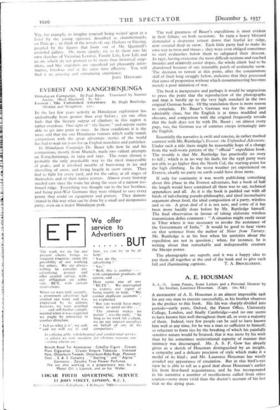To describe Mr. Peter Quennell's attempt to survey the last
fifty years or so of the nineteenth century, " solely through the
medium of photography," as a snapshot of an age will give a general idea, perhaps, of its scope and interest. It is not an altogether satisfactory definition, because it does not cover Mr. Quennell's written commentary. But it does, I think, serve its purpose in drawing a distinction between the method Mr. Quennell has chosen to describe the Victorian scene and the method of a historian, like Mr. G. M. Young, in his Portrait of an Age. The two books are complementary, Mr. Young's portrait revealing the features of the age by a synthesis of the prevailing ideas and cross-currents of thought and action, Mr. Quennell's photographic record providing material for an analysis of some of the more obvious features as revealed by the camera. It would be idle to discuss which is the more fruitful method, or, even, which is the more exact ; as idle, indeed, as trying to compare a painting and a' photograph of a particular person or scene. It is perhaps enough to saY that Mr.. Quennell's method, which is :likely to find many imitators in the future, is entertaining and full of possibilities. . If he has not exhausted them all, it is partly because the material at his disposal is limited and partly because he has not tried to do more in the eight short and spirited essays that make up his running commentary than skim over the surface of history. Photography was little more than an intriguing, incalculable and rather messy hobby until the end of the nineteenth century. For this reason, Mr. Quennell (and his publishers) are to be congratulated on the excellence of the choice they have made from a very modest range. There are more than iso reproductions in the book—portraits, street scenes, still-lives, conversation pieces—and it is particularly interesting to find that, as in printing, so in photography, some of the finest work was produced by the earliest exponents. The " incunabula " of amateurs such as Octavius Hill and Fox-Talbot, and at a later period of Mrs. Cameron, are, in design and composition, equal and, in some cases, superior to the technically more efficient " portrait studies " of the modern photographer.
The camera is supposed to be unable to tell a lie. Yet I cannot help wondering if some of Mr. Quennell's photographs are telling the truth. I am too young to judge—and so, indeed, is he. Were they really as ugly, as grotesque, as fantastic, as all that ? How much, one wonders, bas truth suffered, first of all at the hands or rather through the eye of the camera, and then _through the distorting eye of Mr. Quennell and finally through those of his readers. Everyone knows how easily a familiar face can be made unrecognisable or strangely altered by the best-intentioned photographer, and how false impressions are quite as often produced by the expert in the studio as by the snapsnotter on the seashore. One thing that makes me suspicious is the fact that in several of the photographs in the book there is a striking contrast between the natural, unaffected appearance of a dog and the posed, artificial look of its owner.
In some ways, these suspicions add to the enjoyment of the illustrations. They certainly induce curious speculations. Try, for example, to imagine yourself being waited upon in a hotel by the young ogresses; described as chambermaids, on Plate 41 ; or think of the novels of, say, Dickens or Gissing, peopled by the figures that loom out of Mr. Quennell's crowded gallery. Or, more simply, try to fit them into his own sketches of Victorian London, Family Life, Low Life and so on, which do not pretend to he more than historical snap- shots, and like snapshots are superficial yet pleasantly infor- mative, frivolous and at the same time effective. You will find it an amusing and stimulating experience.
JOHN HAYWARD.



























































 Previous page
Previous page